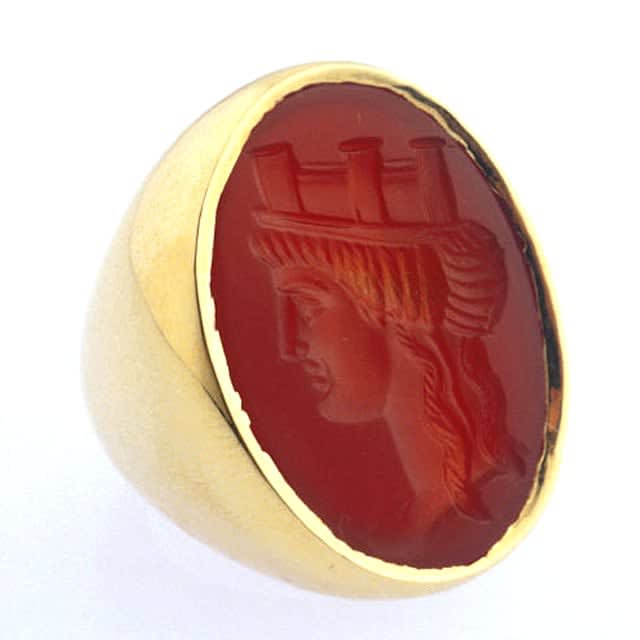Gold Ring Featuring a Classical Revival Carnelian Seal Depicting Tyche, 1700 CE - 1800 CE
Gold and Carnelian
FJ.6290
This antique seal has been mounted in a modern 18 karat gold ring. Tyche, Greek goddess of luck or chance, known as Fortuna to the Romans, was a popular deity...
This antique seal has been mounted in a modern 18 karat gold ring.
Tyche, Greek goddess of luck or chance, known as Fortuna to the Romans, was a popular deity in the Roman world. The benevolent blessings of Tyche were eagerly sought, particularly in matters involving risk taking, contests, business or war. It was not uncommon for a temple of Fortuna to be located near the central business district of a Roman town, so the goddess could preside over the transactions of daily life. Tyche is usually depicted as a beautiful woman dressed in flowing robes and carrying a cornucopia (horn of plenty) as a symbol of wealth and abundance. When she represents a city, she wears a crown of turrets and walls (as in the case of this intaglio). She appears also holding a wheel, a metaphor for life's ever-changing circumstances. Small devotional statues of Fortuna and talismatic jewelry bearing ber image were popular throughout the vast Roman Empire. Her cult survives in the modem world in the person of ‘lady luck’, frequently invoked by gamblers.
Tyche, Greek goddess of luck or chance, known as Fortuna to the Romans, was a popular deity in the Roman world. The benevolent blessings of Tyche were eagerly sought, particularly in matters involving risk taking, contests, business or war. It was not uncommon for a temple of Fortuna to be located near the central business district of a Roman town, so the goddess could preside over the transactions of daily life. Tyche is usually depicted as a beautiful woman dressed in flowing robes and carrying a cornucopia (horn of plenty) as a symbol of wealth and abundance. When she represents a city, she wears a crown of turrets and walls (as in the case of this intaglio). She appears also holding a wheel, a metaphor for life's ever-changing circumstances. Small devotional statues of Fortuna and talismatic jewelry bearing ber image were popular throughout the vast Roman Empire. Her cult survives in the modem world in the person of ‘lady luck’, frequently invoked by gamblers.
